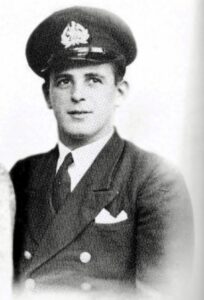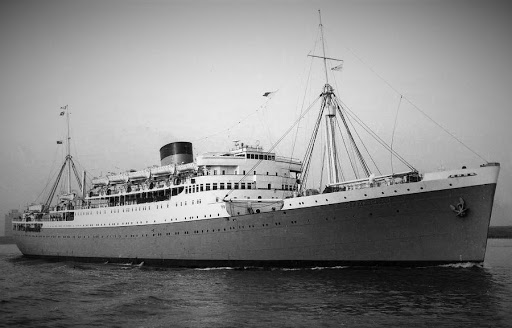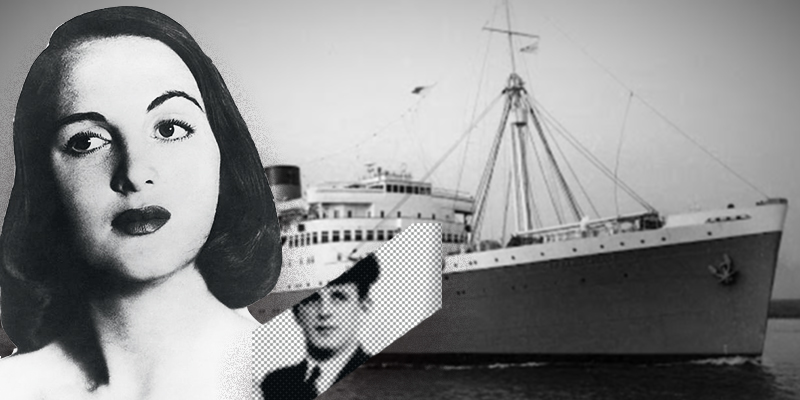By ten a.m. on the morning of Saturday, October 18, 1947, the awful word had gotten round among the other fifty-nine first-class passengers sailing aboard the Durban Castle, an ocean liner situated off the coast of equatorial Africa that was en route to the English city of Southampton from Cape Town, South Africa. Gay Gibson had disappeared!
Gay Gibson, the vanished young woman, was an enchanting auburn-haired, milky-skinned stage actress, only twenty-one years old, who had left her home in South Africa aboard the Durban Castle in order, she told people, to find her fame and fortune strutting upon the boards in England, where she had originally resided with her peripatetic working class, evangelical family. By noon the captain of the ship concluded that the young actress tragically had gone overboard to an all-but-certain doom in the shark-infested ocean. But was there more to it than that? On Friday, October 24, after the Durban Castle had anchored in southern England off the Isle of Wight, two police detectives boarded the ship to conduct an investigation into the mysterious affair. Soon they were escorting the Durban Castle’s handsome, black-haired deck steward, thirty-year-old James “Jimmy” Camb, from the ship to undergo further questioning at Southampton police headquarters. Two days later, on October 26, Jimmy Camb was formally arrested and charged with Gay Gibson’s slaying, albeit in the inconvenient absence of her body. Thus was launched one of mid-century Britain’s most notorious murder cases, like something out of a shipboard mystery by Agatha Christie or one of her crime writing contemporaries.
 A picture of English actress Eileen Gibson, taken during a run of the play ‘Golden Boy’ in South Africa, 1947. In October 1947, during her return voyage to England on the Union-Castle Line vessel Durban Castle, she was murdered by ship’s steward James Camb. (Photo by Keystone/Hulton Archive/Getty Images)
A picture of English actress Eileen Gibson, taken during a run of the play ‘Golden Boy’ in South Africa, 1947. In October 1947, during her return voyage to England on the Union-Castle Line vessel Durban Castle, she was murdered by ship’s steward James Camb. (Photo by Keystone/Hulton Archive/Getty Images)
The outcome of Jimmy Camb’s March 1948 murder trial remains deeply disputed today. Over the years the case has inspired at least nine retellings in true crime books and articles, including Antony M. Brown’s Death of an Actress (2018), as well as a novel, Rachel Heath’s The Finest Type of English Womanhood (2009), and a short story, “Girl Overboard” (originally completed in 1948), by two of the mid-century’s most prominent crime writers, Anglo-Americans Richard Webb and Hugh Wheeler. This latter work itself immediately became enveloped in a publishing mystery, one only recently untangled by myself. Webb and Wheeler’s fictional solution of the Gay Gibson case proved too hot to handle in the aftermath of Jimmy Camb’s trial. How much more so it might have been today, given the authors’ proffered solution to the mystery.
Gay Gibson’s alleged murderer, James Camb, originally haled from Waterfoot, a small mill town in southeast Lancashire, England. Good-looking, smooth-talking and consummately confident, Jimmy Camb determined from a young age that he would escape the tedium of factory life. After a wartime stint in the Merchant Navy Reserve, during which time he married and fathered a child, Camb snagged a job as assistant cook on the Durban Castle, quickly working his way up to the plum position of first-class deck steward, where his honeyed words and movie-star looks (he was compared to Hollywood heartthrob Tyrone Power) secured him generous tips, especially from flattered women passengers, who were urged to call him Jimmy. Resplendent in his white deck uniform, Jimmy Camb, notorious among the crew as the shipboard Lothario (in a nod to the infamous Don Juan he was dubbed “Don James”/“Don Jimmy”), was known to put sexual moves on attractive young woman passengers—a penchant which would place the deck steward in grave legal peril of his life after Gay Gibson tragically went overboard.

Like James Camb, Gay Gibson herself had a “reputation.” In South Africa the attractive young actress had landed, not long after Camb got his own dream job, the lead female role in playwright Clifford Odets’ acclaimed 1937 boxing drama Golden Boy (filmed in 1939 in a production starring Barbara Stanwyck and William Holden). With her alabaster skin, “Bette Davis eyes, sensual lips, and a bob of luxurious red hair that she would twirl for attention,” writes Antony M. Brown, Gay Gibson “attracted men like bees to a honeycomb”—though lovers and friends alike had been concerned over Gibson’s health, particularly her occasional fainting fits, and found her temperamental. According to her cast mates she was sexually active, having carried on affairs with two married men, one of whom (who may have impregnated her) paid her fare when she set out for England aboard the Durban Castle on October 10, 1947. Was Gibson seeking a solution in the mother country, far from her lover’s wife and her own puritanical parents, to the problem of an unwanted baby? Whatever her true motivation for making the trip, Gibson would never live to complete it. In eight days she would be dead and her name shortly thereafter publicized around the world, though emphatically not for reasons which she would have wanted.
The only young woman among the Durban Castle’s sixty first-class passengers, Gay Gibson quickly caught the boldly inquisitive eye of Jimmy Camb. The attractive pair was known to have been friendly with each other on deck and Camb familiarly gossiped about Gibson to other members of the crew, suggesting that the engaging actress and the charismatic steward with the film star looks had established a certain intimacy with each other. Just how far did things go between them?
Around 3:00 a.m. on October 18, the ship’s night watchman, James Steer, answered bells which had simultaneously rung out for both the steward and the stewardess from cabin 126, deck B—Gay Gibson’s cabin. There being no response to his knocking at the cabin door in answer to the summons, Steer began to open it, whereupon he noticed a man turned away him, clad in singlet and trousers, who announced brusquely, “It’s all right” and pushed the door shut. Although he didn’t actually see the man’s face, Steer divulged to crew members that it was none other than that gay dog Jimmy Camb, obviously up to his old tricks again with a likely lady passenger, in this case Gay Gibson. But later that day, what in the early morning hours had seemed just another of Camb’s harmless, if conventionally reprehensible, sexual larks, took on a far more sinister hue, after it was learned that Gibson had gone overboard.

When questioned by the ship’s captain, Camb denied having been the man in Gibson’s cabin, but under police interrogation the steward later admitted that the man glimpsed by Steer had indeed been he. Camb confessed to having engaged in sexual intercourse with Gibson, but insisted that this had been with her consent. He claimed that in the throes of sexual passion Gibson had suddenly clutched at him, foaming at the mouth, and expired. Fearing that the discovery of Gibson dead in her bed would lead to the inevitable exposure of his unprofessional role in her demise, Camb callously took hold of the deceased woman’s body and forced it through the cabin porthole into the ocean. By doing so he hoped he would make it appear that Gibson had simply fallen overboard. Appalling as was the conduct in cabin 126 to which Camb admitted, however, the police put an even more malign spin on it.
At James Camb’s trial for the crime of “murder on the high seas,” which opened at the Great Hall of Winchester Castle on March 18, 1948, the prosecution contended that this was no case of sexual misadventure but rather a cruel and wanton murder. According to the prosecution, Camb had inveigled his way into Gibson’s cabin, assaulted her and then strangled her to death when she virtuously resisted him. There were many points of dispute in the trial, which in the absence of a body was necessarily based on circumstantial evidence. Was Gibson really subject to fainting fits, brought on perhaps by congenital heart disease? Had Gibson, who normally locked her cabin door at night, invited Camb inside in the early morning hours and welcomed his sexual advances? There were scratches on Camb’s body, but had these been made by the dead woman or, as Camb claimed, by the steward himself in the sweltering tropical shipboard atmosphere? There was urine on the cabin bed, but did this point with certainty to Gibson’s death by strangulation? How had the bell-pushes in the cabin come to be rung? And what about Gibson’s black silk pajamas? Camb had insisted that the actress had been naked beneath her dressing gown when he pushed her body through the porthole, but if the black pajamas did not go into the ocean with the dead woman, then what had happened to them? Had Gibson kept her pajamas on while she encountered Camb, it seemed less plausible that she had been, as Camb contended, a compliant partner in a sexual liaison with him.

Earlier in their investigation, police had collected affidavits, which, although they were not introduced at Camb’s trial, suggest a disturbing pattern of sexual conduct aboard the Durban Castle on the steward’s part. According to three young women travelers on the ship, Camb had made insistent and unwanted advances toward them on separate occasions over a short period of time before Gay Gibson’s death, from September 18 to October 7, 1947. In one of the affidavits, one of the women, a certain “Miss B.,” testified that she was taking an afternoon nap in her cabin when she suddenly awoke and found Camb, whom she addressed familiarly as “Jimmy,” kneeling quietly by her bed. “I immediately got up but, before I could completely rise, Jimmy pushed me back onto my bed holding my shoulder,” recalled Miss B., adding:
“I then struggled to get up, but did not succeed as Jimmy got on top of me, his whole body covering mine. In view of the weight of this man on top of me, I was unable to shout, and at the same time he held down my shoulders and kissed me. It was all such a shock to me that I cannot remember all that happened….I told him my aunt was next door to me. This had the desired effect and Jimmy got up, but he forced me down on the bed again. This time I knocked on the wall, and then Jimmy got up and told me to stay as he was going to fetch my tea. He then left my cabin.”
In Death of an Actress Antony M. Brown concludes that Camb sexually assaulted Gay Gibson in a manner similar to that described by Miss B, triggering Gibson’s heart failure in the stultifying cabin as he pressed his body down upon hers and she attempted to resist him, scratching him with the bristles of a hairbrush and hitting the push-buttons for help. This seems to me the most persuasive reconstruction of events and it certainly makes an unsympathetic figure out of Camb, who would have been guilty of sexual assault and manslaughter, if not actual murder. Certainly the jury at Camb’s four-day trial did not sympathize with the defendant, finding him guilty as charged after deliberating merely forty-five minutes. As a result of this verdict, Camb would have been executed had parliament not temporarily suspended the death penalty at this time. No less a figure than opposition leader Winston Churchill thundered that “the House of Commons has, by its vote, saved the life of the brutal lascivious murderer who thrust the poor girl he had raped and strangled through a porthole of the ship to the sharks.”
Later accounts of the trial would take a more nuanced view of the tragic affair than the United Kingdom’s once and future P.M., but they reached different conclusions concerning the question of Camb’s guilt. Death of An Actress, the most recent and arguably definitive account of the Gay Gibson case, has already been mentioned. Three years after the trial, in 1951, Edgar-winning American true crime writers Charles Boswell and Lewis Thompson in The Girl in the Stateroom, a luridly covered yet substantive account of the case published as a paperback original by Gold Medal Books, argued that Camb was indeed guilty of murder. No additional book-length study of the case would appear for forty years (with Denis Herbstein’s The Porthole Murder Case), but in the meantime a number of shorter articles analyzing the affair were published, including “The Porthole Case” by noted British crime writer Julian Symons in his 1960 true crime study A Reasonable Doubt. Symons believed that Camb’s story of sexual misadventure was at least as credible as the prosecution’s claim of ruthless murder and thus he argued that the steward should not have been convicted—there clearly having been, as the title of his book suggests, reasonable doubt.
Back in February 1949, merely ten months after James Camb’s trial, two other prominent crime writers weighed in on the Gibson case, although their take was rendered in fictional form, in a jointly written short story entitled “Girl Overboard.” The authors of this short story were Richard Webb and Hugh Wheeler, who at the time published fiction together under the popular pseudonyms Patrick Quentin, Q. Patrick and Jonathan Stagge. Since February 1947 Webb and Wheeler together as “Q. Patrick” had been publishing detective stories about the investigations of their posh policeman sleuth Lieutenant Timothy Trant in This Week, a nationally syndicated American Sunday newspaper magazine supplement with a readership that numbered in the millions. The fourth of the Trant tales to appear in This Week, likely composed in late 1948, was to be “Girl Overboard,” but upon receipt of the story the magazine’s editor and publisher, William I. Nichols, who claimed he had elevated the fortunes of This Week by abhorring “anything controversial,” balked. Immediately perceiving that “Girl Overboard” was based on the notorious Gay Gibson case, he demanded that the authors alter the ocean liner setting. This alteration Hugh Wheeler, fueled on coffee and cigarettes, accomplished over the course of a single night, with the result that “Murder in the Alps,” the new version of “Girl Overboard,” appeared in This Week in February 1949. The dexterity with which Wheeler in one evening altered an ocean bound shipboard mystery into a snowbound alpine one was a testament to his facility as a professional writer.
Not until October 1950 did the tale as it was originally written actually appear in print, in the Anthony Boucher edited short story anthology Four and Twenty Bloodhounds. A true crime aficionado, Boucher evinced no hesitation about publishing “Girl Overboard,” referring slightingly, if a mite disingenuously, to the unnamed editor who had originally turned down the story for publication: “A timid magazine editor, fancying he saw an analogy with another case then in the papers, insisted that this shipboard episode be completely rewritten and set in an Alpine chalet—a rewrite job which Q. Patrick completed overnight, and astonishingly well.” However, anyone reading “Girl Overboard” who is familiar with the Gay Gibson case would have immediately to discount Boucher’s intimation that any resemblance between the actual case and the short story was merely the result of a tremulous editor’s nervous imagination. Indeed, that “Girl Overboard,” which Boucher deemed one of “Trant’s deftest cases,” was modeled substantially after the deadly affair on the Durban Castle is patently obvious.
In the story Lieutenant Trant is returning across the Atlantic to New York from a month’s vacation in Europe aboard the S. S. Queen Anne. His “particular crony” on the trip is the charming and handsome steward Jimmie, a native of Yorkshire who, “with his sun-bleached hair and lazy smile, was the dream boy of the female tourists and knew it.” Together Trant and Jimmie gossip about the vacuous, attention-grabbing first-class passenger Mavis Marriner, “England’s newest, prettiest, and probably least talented movie star,” who is busily employed in driving to jealous distraction both her French movie star fiancée, Armand Bardou, and her American millionaire playboy admirer, Larry Howard. Trant—who, we are informed, has “unorthodox” taste in women—admits to himself that he has “a certain weakness for Mavis Marriner although, apart from a torrid physical aspect, she had nothing to recommend her. She was both silly and selfish and, although she worked overtime to make every man fall in love with her, she remained—he was sure—technically as virtuous as a police matron….Perhaps it was her youth or perhaps in her he saw the classic example of a murderee.” Already it is easy to see where the sympathies of the authors lie: with Jimmie, aka James “Jimmy” Camb, slightly disguised under his head of “sun-bleached hair,” rather than flighty and fatally flirtatious Mavis Marriner, aka Gay Gibson.
When Mavis one morning is determined to be missing from her cabin, a search divulges that among her possessions only a pair of black silk pajamas is missing. Trant finds a scrap of torn black fabric caught on the porthole, indicating that Mavis went overboard. As he places the shred of material into an envelope, he feels “a cosmic pity for Mavis Marriner and all other foolish young women who reap what they sow.” Later he learns from the night stewardess, a Pole by the name of Mrs. Kuzak, that she received a bell summons to Mavis’ cabin at 1:30 in the morning, but that upon her knocking she was answered by a man’s heavily accented, foreign voice, “Is all right. Only Miss Marriner has trouble with the porthole. Now is fixed.” This clue seems to point to Mavis’ jealous French fiancé, Armand Bardou, as the murderer.
Assessing Mavis’ dubious character, Trant bluntly pronounces: “She vamped like Salome but when the time came to crash through she went colder than a Pilgrim Mother.” To Jimmie, whom Trant has tapped to act as his shipboard “Watson,” Trant puts himself in the position of Mavis’ murderer, speaking in the first person:
“Miss Marriner certainly hurled her all at me last night. Suppose I’d taken her up on it and come here to the cabin expecting a Big Romantic Moment. Where would I have got? The old don’t-touch-me-you-nasty-man. Suppose I was vain, used to easy conquests. Suppose I got rough. Suppose she rang for the stewardess. Suppose I realized what an awkward spot I’d be in if the stewardess reported an attempted assault to the captain. Say I struggled with Mavis trying to keep her from calling out when the stewardess knocked, planning to reason with her later and calm her down. O.K. The stewardess came. I invented some trouble with the porthole to explain the ring and to get rid of her. But later—after the stewardess had gone—I realized to my horror that I had been rougher than I thought. I had strangled Miss Marriner….There was Miss Marriner lying on the bed—dead. I hadn’t intended to kill her, but it was done. I got into a panic. I thought of the porthole….I carried her to the port and pushed her though….All I wanted to do was to get the heck away from the cabin as fast as I could. I hadn’t been a very smart murderer, but then I hadn’t planned to be a murderer at all. How’s that fit, Jimmie?”
Jimmie of course is shortly afterward unmasked as the murderer, after Trant provokes the former mill boy to shout, in his native Yorkshire accent, “She was crazed fur me! She aasked me ter coom oop! Ah didn’t knaw—Ah didn’t mean ter—“ Mrs. Kuzak, whom Trant has cannily concealed nearby, affirms that this was the “foreign” accent she heard in Mavis’ cabin in the early morning hours and the game is up for the handsome blond steward. Trant, however, feels “a twinge of sadness,” as, he sadly admits, he had been “fond of the murderer.” He tells Jimmie, “You didn’t mean to kill her. I’m sure of that and I’ll do everything I can [for you]….I’m sorry, Jimmie….I feel like a heel.” Conveniently forgotten in this heady bromantic haze is any thought of the late flirtatious but frigid Mavis Marriner, “England’s…least talented movie star.” After all, she reaped what she sowed, being a natural murderee.
At Jimmy Camb’s trial, aspects of Gay Gibson’s own sexual history had come up, like her involvement with various men in South Africa and the fact that a contraceptive device had been discovered in her luggage. Gay’s outraged mother, Daisy Gibson, piously insisted that her daughter “was one of the finest types of English womanhood” (thereby incidentally giving rise to the title of Rachel Heath’s 2009 novel) and definitely “not interested in men.” Still, when the pulp publisher Gold Medal Books in 1951 produced their true crime account of the affair, The Girl in the Stateroom, the cover of the book breathlessly characterized Gay Gibson as both a siren and a nymphomaniac: “She was the desire of all men and all men were her desire!” To be sure, images of sexually insatiable “bad girls” sold a plenitude of paperbacks in the United States in the early Fifties and notions of sexual “teases” who “led men on” but proved frustratingly “frigid” in the event were then fashionably current, and would remain so for some time. In the United Kingdom nearly a decade later, Julian Symons wrote dismissively of Gay Gibson in his essay “The Porthole Case,” characterizing the dead woman as “a passionate, hysterical and neurotic girl” who in his view had “probably invited Camb to her cabin.” In light of the three affidavits against him submitted by women passengers of the Durban Castle, however, I myself—in contrast, seemingly, with Richard Webb and Hugh Wheeler (who, to be fair, unlike Julian Symons had neither seen nor heard of the affidavits when they wrote their fictional account of the Gibson case)–have difficulty working up much sympathy for handsome Jimmie Camb, who through his likely looks and winning ways had escaped the drudgery of mill life in Lancashire and, like Gay Gibson, had ambition to achieve greater things in life, only to see his golden dreams crumble to dust.
Saved by merciful chance from the executioner’s rope, James Camb was divorced by his wife on grounds of adultery in December 1948, not long after his incarceration. Deemed a “star prisoner” by authorities, Camb was released from penal servitude at the age of forty-two in September 1959. Like any good Englishman, he promptly sold his story to the press (still denying his guilt) and later married a barmaid, adopting her young daughter. But all too often second chances falter and fail. A dozen years later, in 1971, Camb, while engaged as an employee at a hotel, was charged with breaking into the room of three eleven-year-old schoolgirls, engaging there in the sort of lewd behavior described long ago in her affidavit by the unfortunate “Miss B.” Camb was hastily returned to prison, where he remained until 1978, a year before his death at the age of sixty-two—no longer a dashing dark-haired charmer, Antony Brown notes, but a “sleazy, disheveled….husk of his former self.” Certainly at this bleak and tawdry point the onetime deck steward of the Durban Castle was no fit “crony”—except in a strictly professional capacity of course—for Webb and Wheeler’s Lieutenant Timothy Trant, suavest of police detectives.
Note for the Curious: Both “Girl Overboard” and “Murder in the Alps” were recently reprinted for the first time in Q. Patrick’s The Cases of Lieutenant Timothy Trant (Crippen & Landru, 2019), edited by myself and Douglas G. Greene.

















